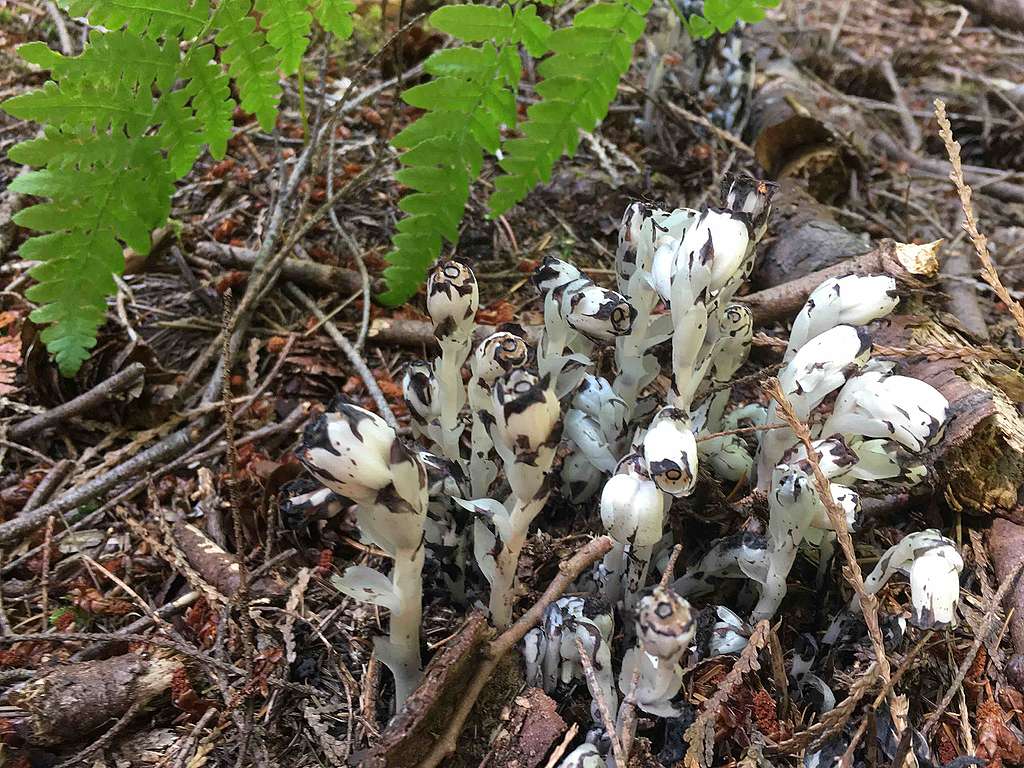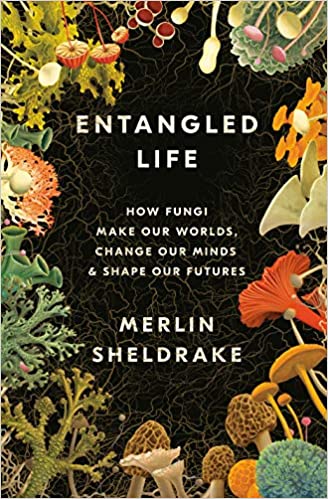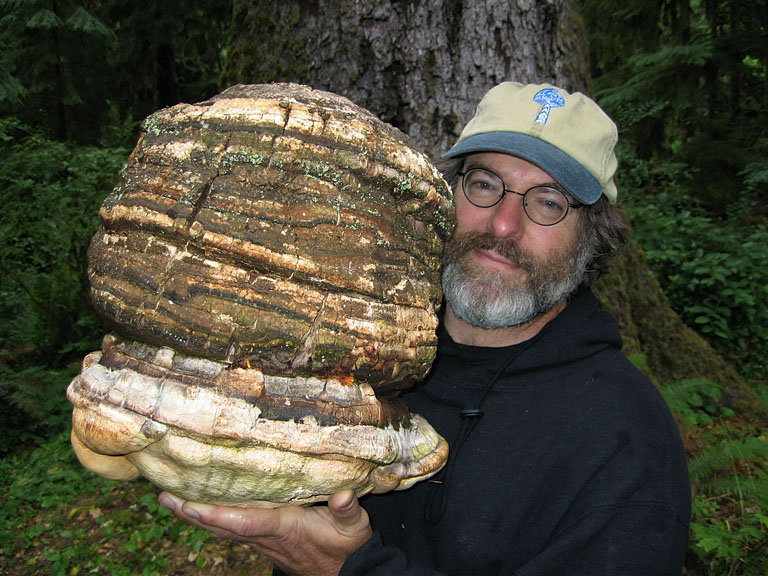by
Rex Weyler
Around mid-summer each year, in the fir and cedar forests of western Canada, where I live, clumps of pure white plants pop up, known locally as “Ghost pipe.” Biologists classify them as Monotropa uniflora, members of the Ericaceae family, cousins to blueberry and rhododendron. However, M. uniflora collects all its nutrients and energy from mycorrhizal fungi, so they don’t bother with photosynthesis, don’t need chlorophyll, and therefore have lost the typical green colouring of plants.
Ghost pipe relies exclusively on the Russulaceae family of fungi, which in turn gets energy and carbon from tree roots, while supplying the trees with nitrogen, phosphorus, and minerals from the soil. We call these fungi-plant relationships “mycorrhizal,” from the Greek mýkēs (fungus) and rhiza, (root). We might think of Ghost pipe as unusual, but 90% of all plant species rely on mycorrhizal fungi, and 400-million years ago fungi made it possible for plants to occupy land habitats in the first place.
“How delicate is the mechanism by which the balance of power is maintained among members of the soil population,” wrote Mabel Rayner in 1945, in Trees and Toadstools. In a 2011 study, in the Netherlands, Toby Kiers and colleagues investigated this “balance of power” among plants and fungi. Using radioactive tags on molecules, they traced carbon and phosphorous exchanges and found that certain plant roots were able to supply carbon preferentially to fungal strains that provided them with more phosphorus. “A trade is taking place,” Kiers concludes, based on what she calls “reciprocal rewards.”
In a new book, Entangled Life
, botanist and mycologist Merlin Sheldrake reviews the latest discoveries and observations, including his own, that characterize the complex world of soils, roots, fungi, bacteria, and microbes. The book reveals how this mycorrhizal web may hold answers to ecological challenges such as bee colony collapse and toxic oil spills.
While reading this book, I found myself pondering deeper questions, such as what it means to identify one species from another, how evolution really works, and how the complexity of soil ecology might inform us about the challenges of human survival and social cohesion.

Who is feeding whom?
Sheldrake and other mycologists call this living soil matrix the “Wood Wide Web,” a magical world where the dividing lines among species — and even among individuals — get blurred.
Some 1.5 billion years ago, fungi, arose as a unique life form about the same time that marine bacteria developed photosynthesis. Fungi form long, exploratory threads — “hyphae” — that are able to break up and mine minerals from rock, so fungi crawled onto land before plants, creating pockets of nutrients and primitive soil. About 400 million years ago, some species of marine algae hitch-hiked inside clusters of hyphae and later gave birth to all future land plants, from Tiger lilies to cedar trees. To this day, most plants depend on their fungal partners to collect nutrients and mine minerals from soils.
On any rocky coastal shoreline or high rock mountain face, one may find various forms of lichen, the progeny of those fungi-algae partnerships. Biologists have identified about 20,000 “species” of lichen, but each one actually consists of at least two distinct and unrelated species, a fungus and an algae. Some lichen incorporate a yeast species or other partner. As a result, the classification of lichen remains ambiguous. Biologists once considered the lichen Dictyonema glabratum to be a single species until gene sequencing revealed that the group comprises 126 different species, possibly hundreds more, and each one a combination of algae and fungi.

If we claw back a little farther, we discover that eukaryote cells (cells with nuclei), arose when one single-cell bacterium enveloped another, which then lived inside it. These encased bacteria evolved into nuclei and mitochondria. Thus, all life begins with symbiosis, with cooperation, not necessarily competition.
In Entangled Life, Sheldrake avoids the temptation to simplify this complexity, and rather leaves the reader with the appropriate uncertainty about what it means to be an “individual” in a completely interwoven, co-evolving world.
For example, cows cannot actually metabolize grass, so they rely on microbes that can, and who make a home in the cow’s four stomachs. So: Are the microbes working for the cow, or is the cow working to collect and chew grass for the microbes? These complex relationships have much to teach us about ecology, and how life actually thrives. “Life,” writes Sheldrake, “is nested biomes all the way down.”
In a 1970 lecture, one of my personal ecology mentors, Gregory Bateson, put it this way: “All divisions are arbitrary.” In “A symbiotic view of life” (Quarterly Review of Biology, v. 87, 2012), Scott Gilbert and colleagues write, “there never have been individuals.”
This is not only a great lesson in ecology, but a potentially useful lesson in social cohesion.
Mycelium running
The services that fungi provide ecosystems goes far beyond supplying nutrients to plants. They move energy, water, hormones, and information signals among plant and microbe populations.
Many orchid species, for example, don’t photosynthesize when they’re young, so they receive energy in the form of carbon compounds from fungal networks. Once they start photosynthesizing, they switch from energy consumer to energy provider, feeding energy, bound in carbon compounds, back to the mycorrhizal network that serves as a kind of energy exchange for the ecosystem.
The Wood Wide Web can distribute hormones that regulate plant development, send signals to other plants in the environment, or circulate toxins that ward off harmful invaders. When aphids attack broad beans, the plant releases aromatic compounds, attracting wasps that prey on the aphids. The plants send the signals
not only through the air, but also through the mycelial network. One studyshowed that the mycorrhizal web can deliver the signal to other bean plants, that have not been attacked, within 24 hours, and that the plants will retransmit the signal, protecting themselves before they are invaded. Similar signals are sent through the mycelial network by fir trees attacked by budworms and by tomatoes infested with caterpillars.
Mycologist Paul Stamets working with the University of Illinois found
that the Agarikon mushroom could combat tuberculosis bacteria, reduce inflammation, and help cure bacterial and viral infections, including cowpox, bird flu, and the herpes virus. Stamets believes that Agarikon and other polypore mushrooms “hold yet-undiscovered medicines of incalculable value,” and that we should protect our forests and soils as public health assets.
Stamets has also found
that polypore mycelia reduce viruses in Honey bees, and may provide a solution to bee colony collapse . Furthermore, Stamets points out, many mushroom species provide “neurogenetic” benefitsto animals, including humans. Benefits include cognitive enhancement, increased synaptic brain connections, immune system regulation, improved brain and neurological performance, memory, creativity, and the regeneration of vision and auditory neurons. Lion’s mane mushrooms can can treat upper respiratory issues and restore hormonal balances.

These phenomena raise provocative evolutionary questions. Why, for example, would a fungal species spend energy and network capacity to help a bean plant or a fir tree? What is the benefit to a fungus for providing cognitive or behavioral changes in animals?
Questions like this take us back to our query, “What is an individual species?” Patterns of ecosystems may have evolved by happenstance, but they endured because they had survival value. However, the survival value may not be just for individual “species,” but for the collective ecosystem. We know that the unit of survival in nature is not the individual. We shall perish as individuals. However, the unit of survival is also not the species. Species also go extinct. What survives, what endures in a natural biome is the system itself, the relationships, the interactions, the coevolution among various life forms. Networks that serve the whole system survive far beyond individuals and species.
Agriculture
In Entangled Life, Sheldrake points out that radiotrophic fungi — those able to metabolize radioactive particles — were the first life forms to occupy Hiroshima after the 1945 nuclear bomb and are now flourishing in the toxic zone around Chernobyl. He discusses how Pleurotus mycelium can digest everything from cigarette butts to oil spills and glyphosate, the toxic compound in the deadly herbicide Roundup. It now appears that fungi will play a crucial role in large-scale ecological restoration of damage done by human activity. All we have to do is let the natural system do its work.
Historians typically include the plow, developed some 6,000 years ago, among humanity’s great inventions. However, the plow was also the first major tool of industrial agriculture, powered by the energy of draft animals, launching the great destruction of soils, which continues to this day.
Shortly after the plow’s appearance, civilizations — such as the agricultural town Çatalhöyük in Turkey and the Harrapa empire in India — began collapsing. The clearing and plowing of fields, eradication of trees and their root networks, depletion and erosion of soils, mono-cropping, elimination of hedgerows, and eventually the poisoning of soils with pesticides, have all contributed to the destruction of mycelial networks that provide services to the entire ecosystem. Deforestation, climate change, and disease contributed to collapse in the past, but the destruction of soils and their mycelial networks stands as a significant factor in ancient and modern social collapse in almost all cases.
Industrial agriculture has mined the soils of carbon and nutrients while disrupting the mycelial networks that naturally replace them. For example, we have depleted our soils of phosphorus, essential for plant growth, and now mine phosphorus to supply fertilizer companies. However, soil fungi mine phosphorus and distribute it throughout an ecosystem in a process hundreds of times more efficient than the industrial mining and distribution of fertilizer. Meanwhile the world’s supply of industrial, mineable phosphorus is dwindling
We have squandered the real wealth of our soils by depleting and destroying these fragile networks. Merlin Sheldrake’s Entangled Life is a good reminder of the path we need to follow to restore our wounded ecosystems.
References, Links:
Sheldrake, Merlin, “Entangled Life: How fungi make our worlds, change our minds, and shape our futures, Penguin Random House
Kiers, E. T.; Duhamel, M.; et al., “Reciprocal rewards stabilize cooperation in the mycorrhizal symbiosis,” Institute of Ecological Science, Vrije Universiteit, 1081 HV Amsterdam, the Netherlands; Environnement.ens.fr, pdf.
Whiteside, M. D.; Werner,G. D. A; Kiers E. T.; et al, “Mycorrhizal Fungi Respond to Resource Inequality by Moving Phosphorus from Rich to Poor Patches across Networks,” Current Biology
Young, B., et al., “Monotropa uniflora: morphological and molecular assessment of mycorrhizae retrieved from sites in the sub-boreal spruce biogeoclimatic zone in central British Columbia,” Mycorrhiza
Gilbert, Scott F., Sapp, J., Tauber, A.; “A symbiotic view of life,” Quarterly Review of Biology
Zdenka Babikova, Lucy Gilbert, et al; “Underground signals carried through common mycelial networks warn neighbouring plants of aphid attack,” Ecology Letters
Babikova, Z.; Johnson, D.; Gilbert, L, et al.; “How rapid is aphid-induced signal transfer between plants via common mycelial networks?,” Communicative & Integrative Biology
“Extracts of Polypore Mushroom Mycelia Reduce Viruses in Honey Bees,” Paul E. Stamets, et al., Nature
, Scientific Reports, volume 8, 2018.
“Mycologist promotes agarikon as a possibility to counter growing antibiotic resistance,” Bob Yirka, Phys.org
“Paul Stamets Epigenetic Neurogenesis Stack,” Nootropedia
“Agarikon: Ancient Mushroom for Modern Medicine,” Paul Stamets, Huffington Post
How Farming Almost Destroyed Ancient Human Civilization,” Annalee Newitz, Gizmodo Archaeology
“People and Space in Early Agricultural Villages: Exploring Daily Lives, Community Size, and Architecture in the Late Pre-Pottery Neolithic,” Ian Kuijt, Journal of Anthropological Archaeology 19, 75–102 (2000).
“Phosphate shortage: The dwindling resource required to grow food,” Toluwase Olukayode, The Conversation, Phys.org

No comments:
Post a Comment
Note: Only a member of this blog may post a comment.